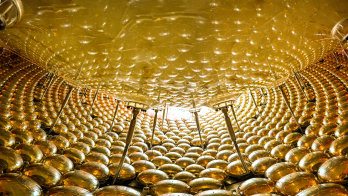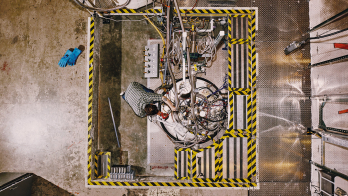Thanks to their large volumes and cost effectiveness, particle-physics experiments rely heavily on gaseous detectors. Unfortunately, environmentally harmful chlorofluorocarbons known as freons play an important role in traditional gas mixtures. To address this issue, more than 200 gas-detector experts participated in a workshop hosted online by CERN on 22 April to study the operational behaviour of novel gases and alternative gas mixtures.
Large gas molecules absorb energy in vibrational and rotational modes of excitation
Freon-based gases are essential to many detectors currently used at CERN, especially for tracking and triggering. Examples run from muon systems, ring-imaging Cherenkov (RICH) detectors and time-projection chambers (TPCs) to wire chambers, resistive-plate chambers (RPCs) and micro-pattern gas detectors (MPGDs). While the primary gas in the mixture is typically a noble gas, adding a “quencher” gas helps achieve a stable gas gain, well separated from the noise of the electronics. Large gas molecules such as freons absorb energy in relevant vibrational and rotational modes of excitation, thereby preventing secondary effects such as photon feedback and field emission. Extensive R&D is needed to reach the stringent performance required of each gas mixture.

CERN has developed several strategies to reduce greenhouse gas (GHG) emissions from particle detectors. As demonstrated by the ALICE experiment’s TPC, upgrading gas-recirculation systems can reduce GHGs by almost 100%. When it is not possible to recirculate all of the gas mixture, gas recuperation is an option – for example, the recuperation of CF4 by the CMS experiment’s cathode-stripchamber (CSC) muon detector and the LHCb experiment’s RICH-2 detector. A complex gas-recuperation system for the C2H2F4 (R134a) in RPC detectors is also under study, and physicists are exploring the use of commonplace gases. In the future, new silicon photomultipliers could reduce chromatic error and increase photon yield, potentially allowing CF4 to be replaced with CO2. Meanwhile, in LHCb’s RICH-1 detector, C4F10 could possibly be replaced with hydrocarbons like C4H10 if the flammability risk is addressed.
Eco-gases
Finally, alternative “eco-gases” are the subject of intense R&D. Eco-gases have a low global-warming potential because of their very limited stability in the atmosphere as they react with water or decompose in ultraviolet light. Unfortunately, these conditions are also present in gaseous detectors, potentially leading to detector aging. In addition to their stability, there is also the challenge of adapting current LHC detectors, given that access is difficult and many components cannot be replaced.
Roberto Guida (CERN), Davide Piccolo (Frascati), Rob Veenhof (Uludağ University) and Piet Verwilligen (Bari) convened workshop sessions at the April event. Groups from Turin, Frascati, Rome, CERN and GSI presented results based on the new hydro-fluoro-olefin (HFO) mixture with the addition of neutral gases such as helium and CO2 as a way of lowering the high working-point voltage. Despite challenges related to the larger signal charge and streamer probability, encouraging results have been obtained in test beams in the presence of LHClike background gamma rays. CMS’s CSC detector is an interesting example where HFO could replace CF4. In this case, its decomposition could even be a positive factor, however further studies are needed.
We now need to create a compendium of simulations and measurements for “green” gases in a similar way to the concerted effort in the 1990s and 2000s that proved indispensable to the design of the LHC detectors. To this end, the INRS-hosted LXCAT database enables the sharing and evaluation of data to model non-equilibrium low-temperature plasmas. Users can upload data on electron- and ion-scattering cross sections and compare “swarm” parameters. The ETH (Zürich), Aachen and HZDR (Dresden) groups illustrated measurements of transport parameters, opening possibilities of collaboration, while the Bari group sought feedback and collaboration on a proposal to precisely measure transport parameters for green gases in MPGDs using electron and laser beams.
Obtaining funding for this work can be difficult due to a lack of expected technological breakthroughs in low-energy plasma physics
Future challenges will be significant. The volumes of detector systems for the High-Luminosity LHC and the proposed Future Circular Collider, for example, range from 10 to 100 m3, posing a significant environmental threat in the case of leaks. Furthermore, since 2014 an EU “F-gas” regulation has come into force, with the aim of reducing sales to one-fifth by 2030. Given the environmental impact and the uncertain availability and price of freon-based gases, preparing a mitigation plan for future experiments is of fundamental importance to the high-energy-physics community, and the next generation of detectors must be completely designed around eco-mixtures. Although obtaining funding for this work can be difficult, for example due to a lack of expected technological breakthroughs in low-energy plasma physics, the workshop showed that a vibrant cadre of physicists is committed to taking the field forward. The next workshop will take place in 2022.









